Abstract
Data on human breast milk and its handling when fed to babies who cannot be breast-fed were reviewed to determine whether the method of processing and storage affected the properties of the milk. Breast milk is normally contaminated by potential pathogens, which seem to produce no ill effects, but it also contains antimicrobial properties which protect against infection. The evidence suggests that pasteurisation not only eliminates pathogenic bacteria but also damages bacteriostatic mechanisms, so making the milk more susceptible to later contamination. Pasteurisation also affects the nutritional properties of milk. Freezing has little effect on milk proteins, while a study on the effect of refrigeration showed that there was little bacterial growth at temperatures below 8 degrees C. Several years' experience of feeding donated raw milk to newborn infants has confirmed that it produces no ill effects. These findings suggest that pasteurisation of donated breastmilk is unnecessary, and it is not recommended, while the decision whether or not to freeze the milk may be made on practical grounds. Raw breast milk can be safely stored at 4-6 degrees C for 72 hours.
Full text
PDF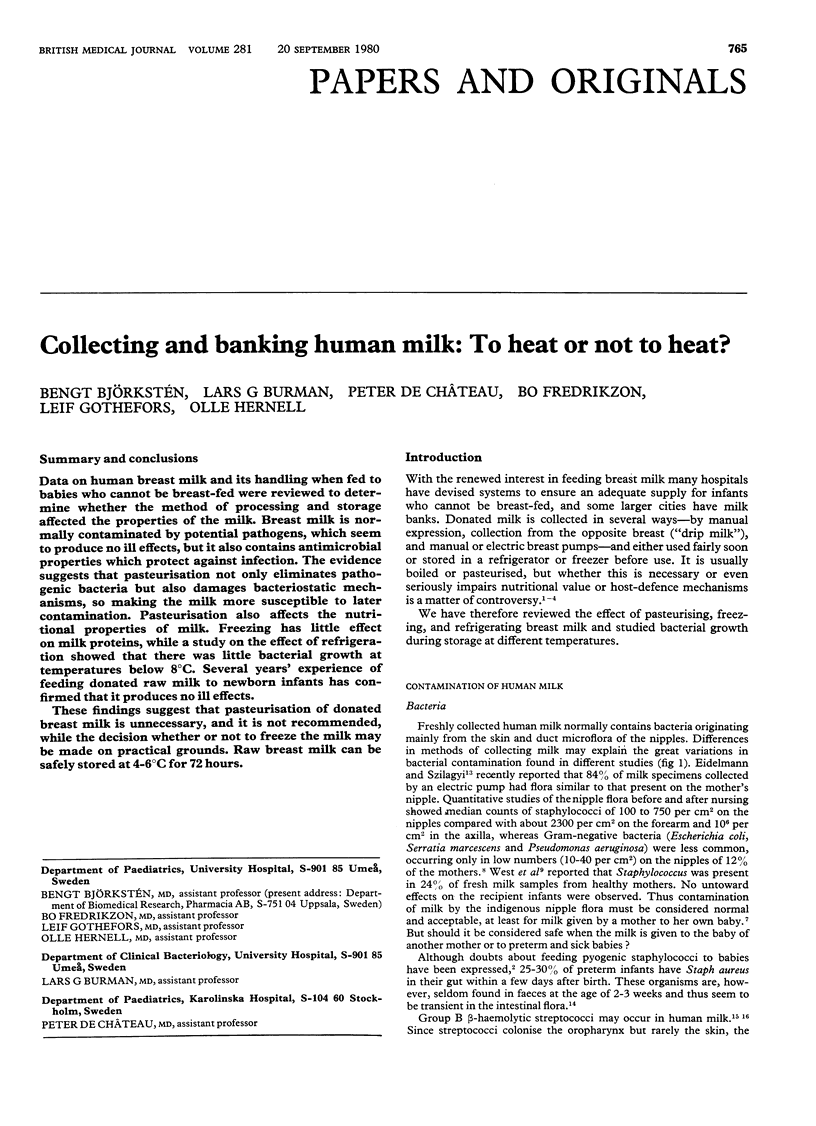
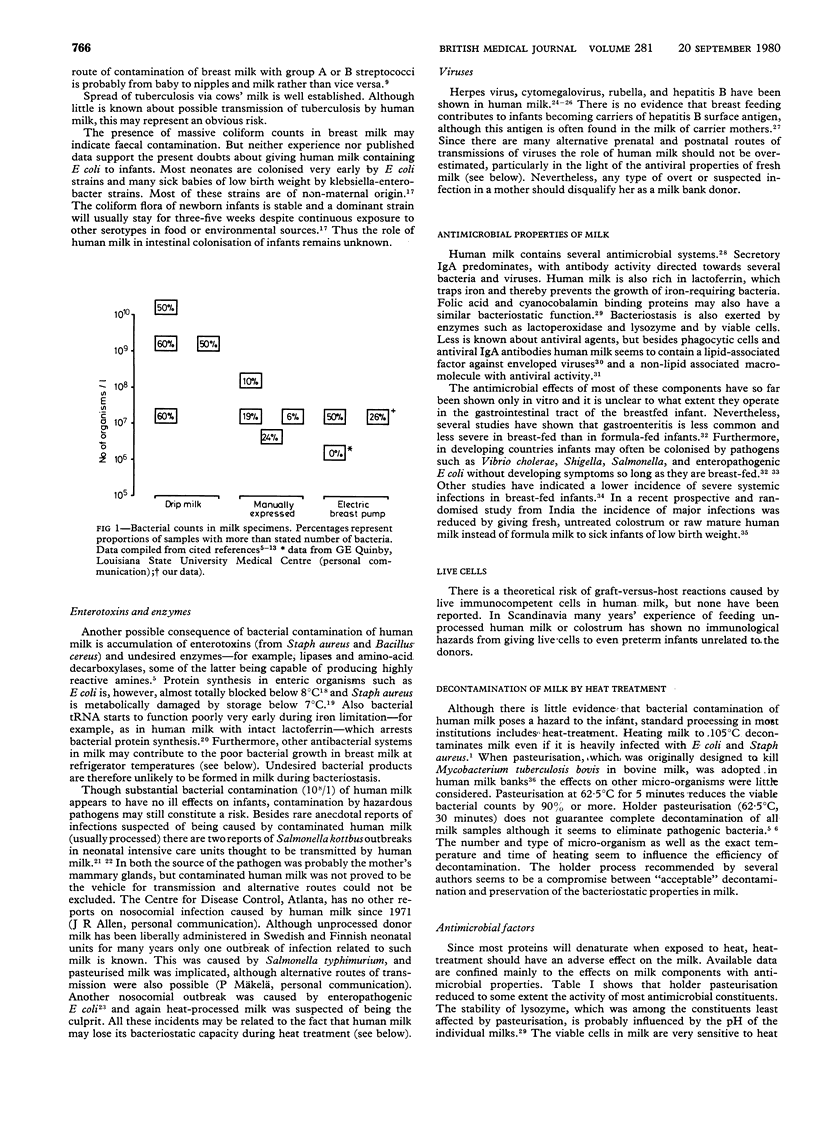
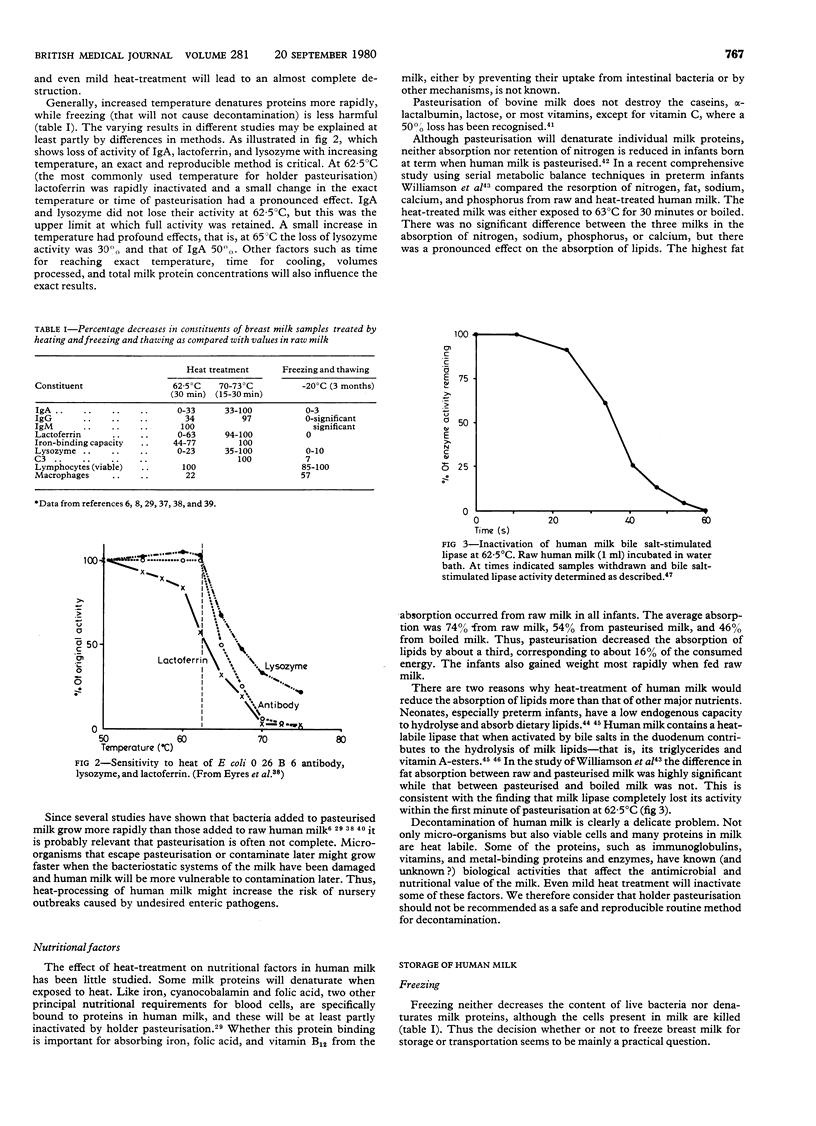
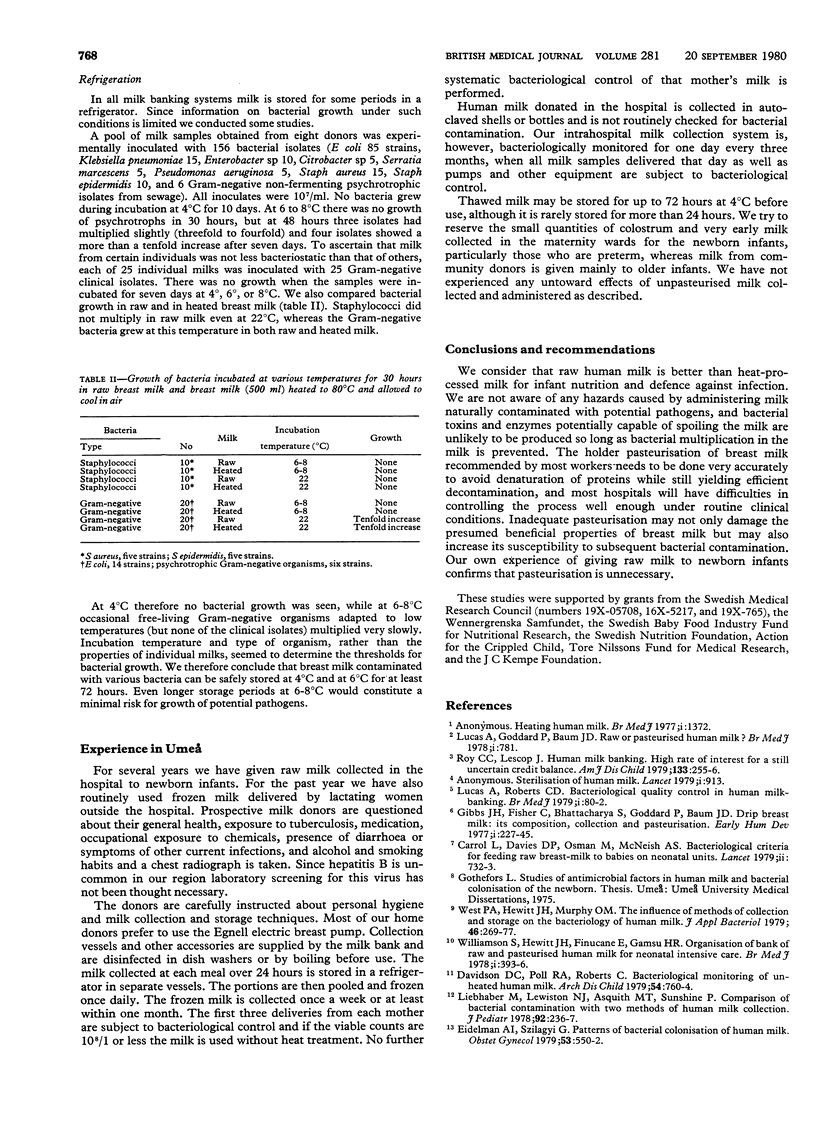
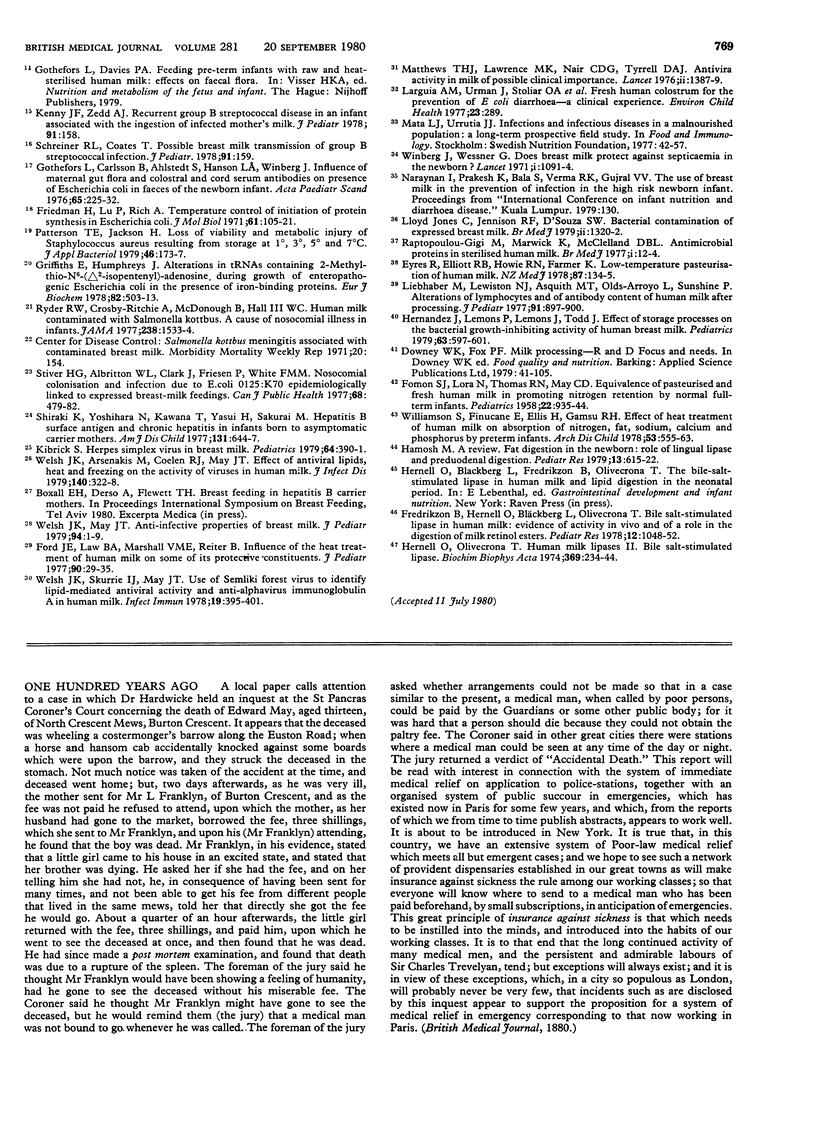
Selected References
These references are in PubMed. This may not be the complete list of references from this article.
- Carroll L., Osman M., Davies D. P., McNeish A. S. Bacteriological criteria for feeding raw breast-milk to babies on neonatal units. Lancet. 1979 Oct 6;2(8145):732–733. doi: 10.1016/s0140-6736(79)90654-8. [DOI] [PubMed] [Google Scholar]
- Davidson D. C., Poll R. A., Roberts C. Bacteriological monitoring of unheated human milk. Arch Dis Child. 1979 Oct;54(10):760–764. doi: 10.1136/adc.54.10.760. [DOI] [PMC free article] [PubMed] [Google Scholar]
- Eidelman A. I., Szilagyi G. Patterns of bacterial colonization of human milk. Obstet Gynecol. 1979 May;53(5):550–552. [PubMed] [Google Scholar]
- Eyres R., Elliott R. B., Howie R. N., Farmer K. Low-temperature pasteurisation of human milk. N Z Med J. 1978 Feb 22;87(606):134–135. [PubMed] [Google Scholar]
- FOMON S. J., THOMAS L. N., MAY C. D. Equivalence of pasteurized and fresh human milk in promoting nitrogen retention by normal full-term infants. Pediatrics. 1958 Nov;22(5):935–944. [PubMed] [Google Scholar]
- Ford J. E., Law B. A., Marshall V. M., Reiter B. Influence of the heat treatment of human milk on some of its protective constituents. J Pediatr. 1977 Jan;90(1):29–35. doi: 10.1016/s0022-3476(77)80759-2. [DOI] [PubMed] [Google Scholar]
- Fredrikzon B., Hernell O., Bläckberg L., Olivecrona T. Bile salt-stimulated lipase in human milk: evidence of activity in vivo and of a role in the digestion of milk retinol esters. Pediatr Res. 1978 Nov;12(11):1048–1052. doi: 10.1203/00006450-197811000-00004. [DOI] [PubMed] [Google Scholar]
- Friedman H., Lu P., Rich A. Temperature control of initiation of protein synthesis in Escherichia coli. J Mol Biol. 1971 Oct 14;61(1):105–121. doi: 10.1016/0022-2836(71)90209-9. [DOI] [PubMed] [Google Scholar]
- Gibbs J. H., Fisher C., Bhattacharya S., Goddard P., Baum J. D. Drip breast milk: it's composition, collection and pasteurization. Early Hum Dev. 1977 Dec;1(3):227–245. doi: 10.1016/0378-3782(77)90037-8. [DOI] [PubMed] [Google Scholar]
- Gothefors L., Carlsson B., Ahlstedt S., Hanson L. A., Winberg J. Influence of maternal gut flora and colostral and cord serum antibodies on presence of Escherichia coli in faeces of the newborn infant. Acta Paediatr Scand. 1976 Mar;65(2):225–232. doi: 10.1111/j.1651-2227.1976.tb16542.x. [DOI] [PubMed] [Google Scholar]
- Griffiths E., Humphreys J. Alterations in tRNAs containing 2-methylthio-N6-(delta2-isopentenyl)-adenosine during growth of enteropathogenic Escherichia coli in the presence of iron-binding proteins. Eur J Biochem. 1978 Jan 16;82(2):503–513. doi: 10.1111/j.1432-1033.1978.tb12044.x. [DOI] [PubMed] [Google Scholar]
- Hamosh M. A review. Fat digestion in the newborn: role of lingual lipase and preduodenal digestion. Pediatr Res. 1979 May;13(5 Pt 1):615–622. doi: 10.1203/00006450-197905000-00008. [DOI] [PubMed] [Google Scholar]
- Hernandez J., Lemons P., Lemons J., Todd J. Effect of storage processes on the bacterial growth-inhibiting activity of human breast milk. Pediatrics. 1979 Apr;63(4):597–601. [PubMed] [Google Scholar]
- Hernell O., Olivecrona T. Human milk lipases. II. Bile salt-stimulated lipase. Biochim Biophys Acta. 1974 Nov 18;369(2):234–244. doi: 10.1016/0005-2760(74)90254-9. [DOI] [PubMed] [Google Scholar]
- Jones C. L., Jennison R. F., D'Souza S. W. Bacterial contamination of expressed breast milk. Br Med J. 1979 Nov 24;2(6201):1320–1322. doi: 10.1136/bmj.2.6201.1320. [DOI] [PMC free article] [PubMed] [Google Scholar]
- Kenny J. F. Recurrent group B streptococcal disease in an infant associated with the ingestion of infected mother's milk. J Pediatr. 1977 Jul;91(1):158–159. doi: 10.1016/s0022-3476(77)80473-3. [DOI] [PubMed] [Google Scholar]
- Kibrick S. Herpes simplex virus in breast milk. Pediatrics. 1979 Sep;64(3):390–390. [PubMed] [Google Scholar]
- Larguia A. M., Urman J., Stoliar O. A., Ceriani J. M., O'Donnell A., Buscaglia J. C., Martinez J. C. Fresh human colostrum for the prevention of E. coli diarrhea--a clinical experience. J Trop Pediatr Environ Child Health. 1977 Dec;23(6):289–290. doi: 10.1093/tropej/23.6.289. [DOI] [PubMed] [Google Scholar]
- Liebhaber M., Lewiston N. J., Asquith M. T., Olds-Arroyo L., Sunshine P. Alterations of lymphocytes and of antibody content of human milk after processing. J Pediatr. 1977 Dec;91(6):897–900. doi: 10.1016/s0022-3476(77)80885-8. [DOI] [PubMed] [Google Scholar]
- Liebhaber M., Lewiston N. J., Asquith M. T., Sunshine P. Comparison of bacterial contamination with two methods of human milk collection. J Pediatr. 1978 Feb;92(2):236–237. doi: 10.1016/s0022-3476(78)80014-6. [DOI] [PubMed] [Google Scholar]
- Lucas A., Goddard P., Baum J. D. Raw or pasteurised human milk? Br Med J. 1978 Mar 25;1(6115):781–781. doi: 10.1136/bmj.1.6115.781. [DOI] [PMC free article] [PubMed] [Google Scholar]
- Lucas A., Roberts C. D. Bacteriological quality control in human milk-banking. Br Med J. 1979 Jan 13;1(6156):80–82. doi: 10.1136/bmj.1.6156.80. [DOI] [PMC free article] [PubMed] [Google Scholar]
- Matthews T. H., Nair C. D., Lawrence M. K., Tyrrell D. A. Antiviral activity in milk of possible clinical importance. Lancet. 1976 Dec 25;2(8000):1387–1389. doi: 10.1016/s0140-6736(76)91922-x. [DOI] [PubMed] [Google Scholar]
- Patterson T. E., Jackson H. Loss of viability and metabolic injury of Staphylococcus aureus resulting from storage at 1 degree, 3 degrees, 5 degrees and 7 degrees C. J Appl Bacteriol. 1979 Feb;46(1):173–177. doi: 10.1111/j.1365-2672.1979.tb02596.x. [DOI] [PubMed] [Google Scholar]
- Roy C. C., Lescop J. Human milk banking: high rate of interest for a still uncertain credit balance. Am J Dis Child. 1979 Mar;133(3):255–256. [PubMed] [Google Scholar]
- Ryder R. W., Crosby-Ritchie A., McDonough B., Hall W. J., 3rd Human milk contaminated with Salmonella kottbus. A cause of nosocomial illness in infants. JAMA. 1977 Oct 3;238(14):1533–1534. [PubMed] [Google Scholar]
- Schreiner R. L., Coates T., Shackelford P. G. Possible breast milk transmission of group B streptococcal infection. J Pediatr. 1977 Jul;91(1):159–159. doi: 10.1016/s0022-3476(77)80474-5. [DOI] [PubMed] [Google Scholar]
- Shiraki K., Yoshihara N., Kawana T., Yasui H., Sakurai M. Hepatitis B surface antigen and chronic hepatitis in infants born to asymptomatic carrier mothers. Am J Dis Child. 1977 Jun;131(6):644–647. doi: 10.1001/archpedi.1977.02120190038007. [DOI] [PubMed] [Google Scholar]
- Stiver H. G., Albritton W. L., Clark J., Friesen P., White F. M. Nosocomial colonization and infection due to E. coli 0125:K70 epidemiologically linked to expressed breast-milk feedings. Can J Public Health. 1977 Nov-Dec;68(6):479–482. [PubMed] [Google Scholar]
- Welsh J. K., Arsenakis M., Coelen R. J., May J. T. Effect of antiviral lipids, heat, and freezing on the activity of viruses in human milk. J Infect Dis. 1979 Sep;140(3):322–328. doi: 10.1093/infdis/140.3.322. [DOI] [PubMed] [Google Scholar]
- Welsh J. K., Skurrie I. J., May J. T. Use of Semliki forest virus to identify lipid-mediated antiviral activity and anti-alphavirus immunoglobulin A in human milk. Infect Immun. 1978 Feb;19(2):395–401. doi: 10.1128/iai.19.2.395-401.1978. [DOI] [PMC free article] [PubMed] [Google Scholar]
- West P. A., Hewitt J. H., Murphy O. M. Influence of methods of collection and storage on the bacteriology of human milk. J Appl Bacteriol. 1979 Apr;46(2):269–277. doi: 10.1111/j.1365-2672.1979.tb00820.x. [DOI] [PubMed] [Google Scholar]
- Williamson S., Finucane E., Ellis H., Gamsu H. R. Effect of heat treatment of human milk on absorption of nitrogen, fat, sodium, calcium, and phosphorus by preterm infants. Arch Dis Child. 1978 Jul;53(7):555–563. doi: 10.1136/adc.53.7.555. [DOI] [PMC free article] [PubMed] [Google Scholar]
- Williamson S., Hewitt J. H., Finucane E., Gamsu H. R. Organisation of bank of raw and pasteurised human milk for neonatal intensive care. Br Med J. 1978 Feb 18;1(6110):393–396. doi: 10.1136/bmj.1.6110.393. [DOI] [PMC free article] [PubMed] [Google Scholar]
- Winberg J., Wessner G. Does breast milk protect against septicaemia in the newborn? Lancet. 1971 May 29;1(7709):1091–1094. doi: 10.1016/s0140-6736(71)91836-8. [DOI] [PubMed] [Google Scholar]


